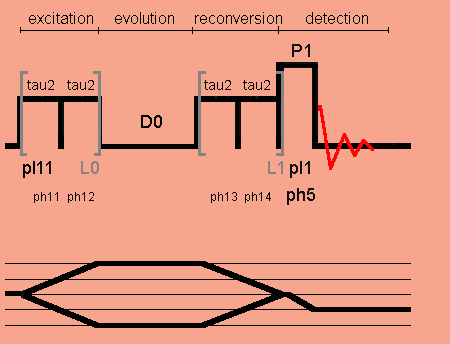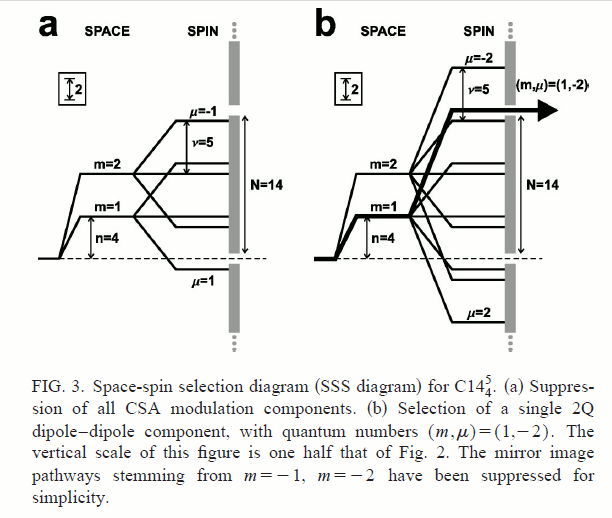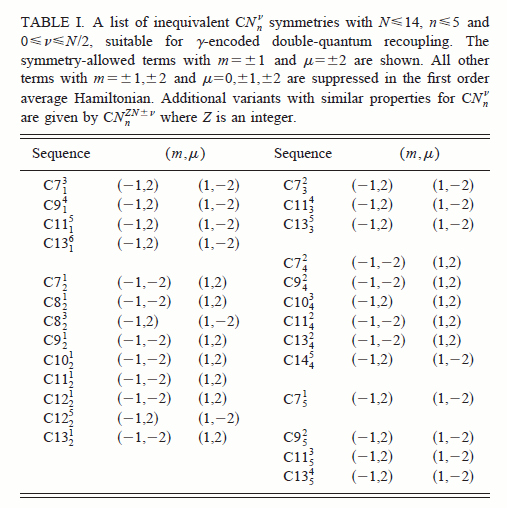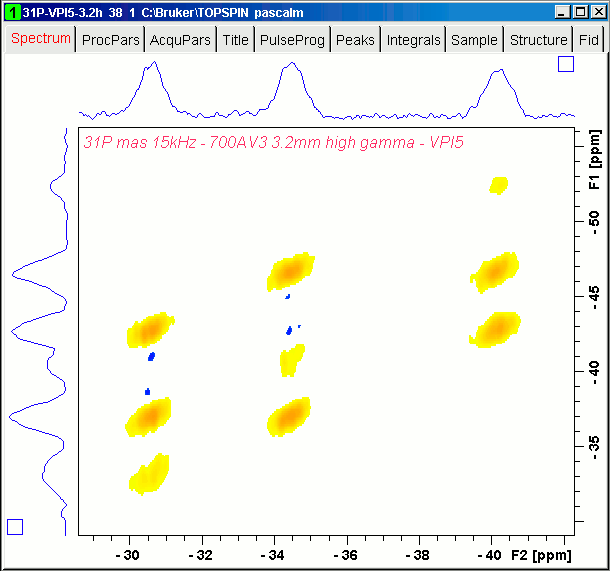
C14_4^5bsw-2d: 2D big F1 spectral width double quantum / single quantum correlation C1445 pulse program (TopSpin2.1)

C14_4^5bsw-2d: 2D big F1 spectral width double quantum / single quantum correlation C1445 pulse program (TopSpin2.1)

Since non-phase cycling is applied to the C14_4^5 excitation pulse, four-phase cycling is applied to the detection pulse P1 for selecting the 0Q -> -1Q coherence order jump, and four-phase cycling is applied to the C14_4^5 reconversion pulse for filtering DQ coherences.


Andreas Brinkmann, Mattias Edén, and Malcolm H. Levitt, Synchronous helical pulse sequences in magic-angle spinning nuclear magnetic resonance: Double quantum recoupling of multiple-spin systems, J. Chem. Phys. 112, 8539-8554 (2000).
;c14-4-52dbsw (TopSpin 2.1) ;2D SQ-DQ correlation experiment with C14_4^5 sequence ;by GALT, Nov. 2, 2001 ;DQ correlation - inadequate type sequence ;C14_4^5 sequence for lower RF requirements (as compared e.g. to C7) ;for setup use c14-4-51d ;requires high spin rates to cover large frequency range (e.g. 20 kHz at 600 MHz) ;Avance III version ;parameters: ;d0 : =0.1u, t1 evolution ;d1 : recycle delay ;p1 : f1 presaturation pulses and detection pulse at pl1 ;p9 : used as t1 increment for d0 ;pl11 : Power level for C14_4^5 recoupling sequence B1=3.5*cnst31 in Hz ;cnst10 : =-180*cnst31*d0, recalculated during acquisition ;cnst31 : spinning frequency ;l0 : number of composite C14_4^5 cycles (usually a multiple of 7) ;ndo : 1 ;FnMode : undefined ;mc2 : STATES-TPPI ;WDW : f1 QSINE 3, f2 QSINE 2 or EM ;use "xau xfshear rotate" to shift spectrum suitably along f1 ;ns : = 16*n ;zgoptns :-Dpresat or blank ;$COMMENT=SQ-DQ experiment with C14_4^5 sequence ;$CLASS=Solids ;$DIM=2D ;$TYPE=direct excitation ;$SUBTYPE=homonuclear correlation ;$OWNER=Bruker define loopcounter count ;for STATES-TPPI procedure "count=td1/2" ;and STATES cos/sin procedure define pulse tau2 "tau2=((1s/cnst31)/7)" ;180° pulse "d31=1s/cnst31" ;one rotor period ;cnst11 : to adjust t=0 for acquisition, if digmod = baseopt "acqt0=1u*cnst11" #include <rot_prot.incl> ;protect for too slow rotation ze "d0=0.1u" ;make sure a short d0 is used initially 1 d31 #ifdef presat ;set with -Dpresat pres, d20 ;delay between saturation pulses (p1 pl1 ph1):f1 ;saturation loop if required lo to pres times l20 #endif /* presat */ 2 d1 ;recycle delay "cnst10=-180*cnst31*d0" ;phase correction for C14_4^5 reconversion pulse, ;due to t1 DQ evolution period, ;defined by the phase-time relationships 1m rpp11 ;reset the phase ph11 pointer to the first element 1m rpp12 ;reset the phase ph12 pointer to the first element 1m rpp13 ;reset the phase ph13 pointer to the first element 1m rpp14 ;reset the phase ph14 pointer to the first element 1u pl11:f1 ;switch to C14_4^5 RF condition ;C14_4^5 excitation 3 (tau2 ph11 ipp11 ipp13 ipp14):f1 ;first 180° C14_4^5 excitation pulse at pl11 ;increment phase ph11 pointer ;increment reconversion pulse phase ph13 and ph14 pointers (tau2 ph12 ipp12):f1 ;second 180° C14_4^5 excitation pulse, ;increment phase ph12 pointer lo to 3 times l0 ;l0 = multiple of 14 d0 ;DQ evolution period ;C14_4^5 reconversion 4 (tau2 ph13+cnst10 ipp13):f1 ;first 180° C14_4^5 reconversion pulse, ;increase ph13 by cnst10 due to evolution period, ;increment phase ph13 pointer (tau2 ph14+cnst10 ipp14):f1 ;second 180° C14_4^5 reconversion pulse, ;increase ph14 by cnst10 due to evolution period, ;increment phase ph14 pointer lo to 4 times l0 ;l0 = multiple of 14 (p1 pl1 ph5):f1 ;detection pulse flips magnetization into the xy plane 2u gosc ph31 ;gosc does not loop to 1 ;start ADC with ph31 signal routing ;DQ filtering (four phase cycling): 1m ip13*16384 ;increments all phases of ph13 by 90° 1m ip14*16384 ;increments all phases of ph14 by 90° lo to 1 times ns ;next scan 100m wr #0 if #0 zd ;delay for disk I/O, store signal, ;increase FID number ;delete memory data ;do not perform dummy scans ;with next acquisition 1m ip11*8192 ;increments all phases of ph11 by 45°, ;90° phase for DQ coherence 1m ip12*8192 ;increments all phases of ph12 by 45°, ;90° phase for DQ coherence lo to 1 times 2 t1 quadrature detection "d0=d0+p9" ;set p9=increment for F1 (to make it usec!) ;1m rp11 ;reset all phases of ph11, ph12, ph13, and ph14 ;1m rp12 ;to their original values, i.e. to the values they ;1m rp13 ;had before the first ip11, ip12, ip13, and ip14 ;1m rp14 ;in case of STATES remove semicolon at beginning of the 4 lines lo to 1 times count ;count=td1/2 HaltAcqu, 1m exit ph1= 0 ;for saturation pulses ph11=(65536) 0 23406 46811 4681 28087 51493 9362 ;C14_4^5(0..6) 32768 56174 14043 37449 60855 18725 42130 ;C14_4^5(7..13) ph12=(65536) 0 23406 46811 4681 28087 51493 9362 32768 56174 14043 37449 60855 18725 42130 ph13=(65536) 0 23406 46811 4681 28087 51493 9362 32768 56174 14043 37449 60855 18725 42130 ph14=(65536) 0 23406 46811 4681 28087 51493 9362 32768 56174 14043 37449 60855 18725 42130 ;;C14_4^5 excitation and reconversion pulse phases ;are identical ph5= 0 0 0 0 2 2 2 2 1 1 1 1 3 3 3 3 ph31 = 0 2 0 2 2 0 2 0 1 3 1 3 3 1 3 1 ;ph31 = ph5 + 2*ph13

31P C1445 DQ-SQ spectrum of VPI-5 zeolite with large DQ F1 spectral width; 3.2 mm-diameter rotor spinning speed: 15 kHz; high frequency Trigamma probehead, P-Al setting.
Pulseprogram parameters for c14a2d.ppm:
| General | |
| PULPROG | c14a2d.ppm |
| TD | 1024 |
| NS | 48 |
| DS | 0 |
| SWH [Hz] | 25000.00 |
| AQ [s] | 0.0205500 |
| RG | 256 |
| DW [µs] | 20.000 |
| DE [µs] | 5.00 |
| CNST11 | 0.0000000 |
| CNST31 | 15000.0000000 |
| D0 [s] | 0.00000100 |
| D1 [s] | 10.00000000 |
| D20 [s] | 0.00800000 |
| d31 [s] | 0.00006667 |
| L0 | 40 |
| L20 | 20 |
| P9 [µs] | 28.57 |
| ZGOPTNS | -Dpresat |
| count | 64 |
| Channel f1 | |
| CNST10 | 1.0000000 |
| NUC1 | 31P |
| P1 [µs] | 4.30 |
| PL1 [dB] | -1.50 |
| PL11 [dB] | 0.00 |
| SFO1 [MHz] | 283.4113792 |
| tau2 [µs] | 9.52 |
Acquisition parameters:
| F2 | F1 | |
| Experiment | ||
| PULPROG | c14a2d.ppm | |
| AQ_mod | DQD | |
| FnMODE | undefined | |
| TD | 1024 | 128 |
| NS | 48 | |
| DS | 0 | |
| TD0 | 1 | |
| Width | ||
| SW [ppm] | 88.2110 | 123.5016 |
| SWH [Hz] | 25000.000 | 35001.750 |
| IN_F [µs] | 28.57 | |
| AQ [s] | 0.0205500 | 0.0018285 |
| Nucleus1 | ||
| NUC1 | 31P | 31P |
| O1 [Hz] | -6439.85 | -6439.85 |
| O1P [ppm] | -22.722 | -22.722 |
| SFO1 [MHz] | 283.4113792 | 283.4113792 |
| BF1 [MHz] | 283.4178190 | 283.4178190 |